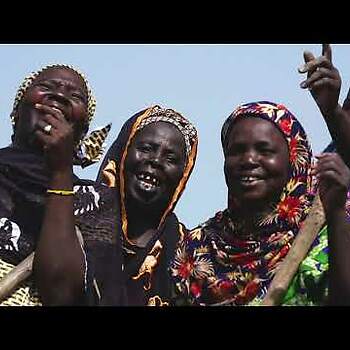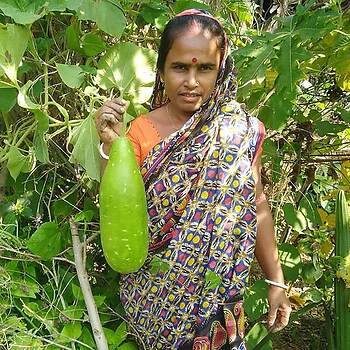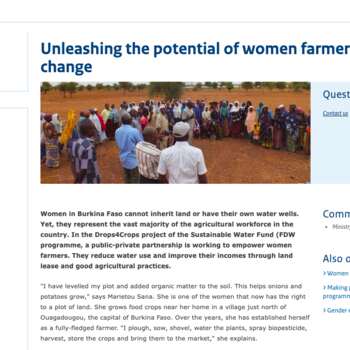Women in agriculture: different situations
Agriculture has often been a focus of Dutch funded economic development programs, either bilateral, multilateral or through NGOs. Agriculture is a main livelihood for most rural women and their families in developing countries, and agricultural programs always affected them. Women farmers often work as unpaid labor on family farms. They may (also) cultivate their own plot and/or homestead. Poor women, especially from landless families, hire themselves out as workers (daily wage laborers) to larger farms. Some more entrepreneurial women may run micro- or small businesses within the agricultural value chain.
Initial approach: from welfare approach to WID (1970 – 1985)
In the 1970s, the support of the Dutch Ministry of Foreign Affairs (MFA) to rural women was mainly channeled through multilateral organizations like the UN Food and Agriculture Organization (FAO), the International Labour Organization (ILO) and international agricultural research institutes working under the CGIAR umbrella. Early programs followed a ‘welfare’ approach. They were mainly based on traditional and gender-biased roles of women. Till the 1980s economic activities targeting women, if any, were mainly related to women’s domestic work, such as cooking and food processing, often labelled as ‘home economics’.
From the 1980s onwards the Women in Development (WID) approach gained ground. Both MFA and Dutch funded multisectoral development NGOs, such as Cordaid and ICCO, started supporting income generating activities (IGAs) for rural women. This could be a component of a larger agricultural program or as a standalone project. Typically, these first IGAs were an extension of women’s domestic (or reproductive) roles, such as food processing, basket making or sewing. However, sales and marketing of the products that women produced had often not been considered when planning the IGAs, with cost-benefit analyses not been done. As a result, women often hardly earned from this work, and many of these IGAs were discontinued.
In early rural and agricultural development program the actual or potential roles of women in agricultural production were hardly acknowledged. Too often the concept ‘farmer’ was understood as being only male, based on a ‘male breadwinner – housewife’ stereotype. Consequently, support to farmers, such as agricultural extension and input supply, was targeted on male farmers only.
From 1983: microfinance for rural women – a paradigm shift
The lives of many rural women started changing when in 1983 Dr. Yunus established the Grameen Bank in Bangladesh. This ‘social bank’ issued microcredit mainly to poor women organized in groups, whereby the group stands guarantee (‘solidarity’) for repayment of the loans, instead of material collaterals such as land. These credits were accompanied by awareness raising, skill training, financial literacy and saving options. Microcredits were only provided for viable IGAs, mostly related to homestead gardening, animal husbandry or food processing, and with sufficient demand in the market enabling women to earn income and repay the loan. In 2011, 97% of Grameen’s loanees were women.
This access to finance, combined with (skill) training, was a huge change in the economic situation for many rural women, often also improving their social position. The microfinance model was soon copied by many NGOs and (micro)finance institutions, spreading to all continents, with women commonly as the main loanees.
The many agricultural (extension) programs implemented at this time (1980s – early 1990s) continued to remain gender blind, ignoring women as (subsistence) farmers. These programs rather focused on introducing technical innovations and extension messages for cash crops targeting male farmers.
Gender mainstreaming enhanced after Beijing 1995 – but agriculture no longer MFA priority
From the early 1990s onwards the Gender and Development (GAD) approach became adopted. Instead of focusing on women separately, attention shifted to addressing gender gaps and enhancing gender equality within core activities of development programs, rather than adding a so-called women’s component to a project. Gender mainstreaming was enhanced by the Beijing Declaration and Platform of Action (1995). The need for improving the enabling environment for women’s economic empowerment, such as legislation about women’s access to land, was also recognized. In many countries the Ministries of Agriculture made first efforts to reach out to women farmers as well. However, within Dutch development cooperation, agriculture and rural development did not receive priority anymore in the period between end 1990s to 2008.
2008: a turning point
In 2008 the World Development Report on Agriculture was published by World Bank. MFA became interested again in agriculture as a driver for development. This resulted into a Joint Policy, drafted by MFA and the Dutch Ministry of Agriculture (LNV). Support to the agricultural sector became a key focus again within development cooperation. Female farmers were acknowledged as important actors in achieving food security, but their inclusion was initially not well structured.
In 2010 the Dutch platform Agri-ProFocus, with the support of MFA, initiated a knowledge focused program on Gender in Value Chains. The start of the program signified a double shift. Firstly, from women-only activities to a focus on agricultural interventions that recognized the work of men and women famers ensuring that all benefit from agricultural production. Secondly, it also marked the shift from focusing on agricultural production only to a ‘value chain’ approach, considering the entire range of actors, from input supply and production to sales and consumption.
A sound gender analysis was considered important for upgrading all segments of the agricultural value chains, including those in which women farmers were active. Gender inequalities in access to and control over land, resources, technical support and relevant decision-making needed to be identified in order to address the hindering factors for women’s equal participation. The Agri-ProFocus initiative created much awareness and offered practical tools to funding agencies, developers and implementers of agricultural programs. Initially, the Gender in Value Chains program targeted governmental and NGO audiences, but the program was expanded to be also relevant to agribusiness actors.
Gender mainstreaming in Dutch funded food security programs became more common. An example is the Blue Gold Program (2013-2021) in Bangladesh where women farmers were explicitly targeted (e.g. forming 64% of all Farmer Field School participants) and gender equality messages integrated in extension content, contributing to (economic) empowerment of women.
Many MFA co-financed multilateral organizations – like FAO and ILO — and the international agricultural research institutes under the umbrella of CGIAR improved their gender strategies as well. For example, in 2012 IFPRI, together with others, developed an innovative tool: the Women’s Empowerment in Agriculture Index (WEIA). This index measures women’s empowerment relative to men’s empowerment across five domains related to agriculture.
Addressing women’s farmers structural barriers: access to land
Access to and control over land is a crucial production factor, often constrained for women by customary or formal laws. Dutch NGOs had already since the 1980s supported activist local partners in initiatives for women farmers to acquire land. But it was in 2008 that the Dutch development policy explicitly included access to land for women, even though it was not consistently applied, see IOB evaluation of 2015. The theme became a policy-priority under the MDG3 Fund (2008-2011) and the FLOW Funds (2012-2020). For example, the NIZA (now called ActionAid) project under MDG3 had a strong focus on women’s land rights in several Southern African countries.
Women’s access to land and/or land rights became also incorporated into various Dutch country programs, like Burundi, Mozambique and Rwanda. Some individual Dutch funded projects addressed access to land for women, for example the Char Development and Settlement Project (CDSP) in Bangladesh, where land issued to poor families was registered in the name of husband and wife jointly.
In recent years other MFA supported initiatives related to access to land and land governance also explicitly included attention to women’s access and rights. Examples are (1) LANDac, the Netherlands Land Academy, which is a partnership between Dutch knowledge organizations and their Southern partners working on land governance for equitable and sustainable development, established in 2010. And (2) LAND-at-Scale, the subsidy program for land governance support in developing countries launched in 2019.
Women as entrepreneurs in the agricultural value chain
Various Dutch funded projects that included attention to value chain development gradually paid more explicit attention to also supporting (potential) women entrepreneurs. Three main types of micro or small entrepreneurship can be distinguished here. (1) Women farmers developing their agricultural production as a commercial business, such as poultry rearing. (2) Women establishing a small business providing inputs or services within the agricultural value chain, such as running a commercial mill or an agricultural input store. And (3) women as sellers and traders of agricultural produce, such as selling vegetables at markets. Relevant training of and support to potential women entrepreneurs was often a key factor for success, such as including financial literacy and market orientation in the curriculum of agricultural training (such as Farmer Field Schools), and selecting women for training for agricultural input supplier (needed to get a license). For many women entrepreneurs access to finance is key.
The Dutch Agri-ProFocus network, with 35 members active in the agricultural sector, had started in 2008 a series of learning activities addressing the question: How to integrate gender in our value chain work? This research on gender in agricultural value chains was an important milestone, going beyond mainly seeing women as (family) workers in agriculture instead of proper value chain actors. In 2012 the publication of Challenging Chains to Change – Gender Equity in Agricultural Value Chain Development, was jointly produced by KIT (Royal Tropical Institute), Agri-ProFocus and IIRR (based in Kenya). This initiative created awareness among funding agencies and offered tangible tools to developers and implementors of development programs, such as a toolkit for gender mainstreaming in agricultural value chains, and a toolkit on sustainable coffee as a family business. From 2019 onwards Agri-ProFocus started to target business actors as well, showing the benefits of investments in women’s economic empowerment for private companies.
An example of a Dutch funded program that supports entrepreneurs in agricultural value chains is 2SCALE: Toward Sustainable Clusters in Agribusiness through Learning and Entrepreneurship. It is an incubator program for inclusive agribusiness in Africa, supporting entrepreneurial farmer producer organizations and -mainly formal- SMEs that process or trade the produce of farmers, often up till consumer markets. Of all SMEs supported by 2SCALE 50% is women-led. The program started in 2012 and was extended to 2023. It is implemented by IFDC (International Fertilizer Development Centre), Bopinc and SNV. By 2022 2SCALE had supported 5000 MSMEs and producer organizations to participate in inclusive value chains and to develop innovative business strategies. To foster women’s entrepreneurship, the program undertook capacity building of women, promoted labor-saving technologies, and improved women’s inclusion and leadership in farmers organizations. In 2017 2SCALE published a paper on gender mainstreaming in agribusiness partnerships.




